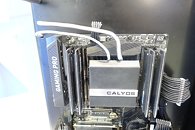Friday, June 2nd 2017
Calyos Showcases Its NSG S0 Phase Change Cooling Chassis at Computex 2017
Remember that Kickstarted case from Calyos, which promises to be the ending of spinning fans on your rig? Calyos is showcasing it at this year's Computex.
The production chassis is designed by France's modding duo WaterMod, which improved upon the original open-frame concept design both in terms of performance and aesthetics. The usage of Phase Change cooling through two cooling blocks - one for the GPU, another for the CPU) makes away with fans, pumps, water, and any other assorted cooling techniques that involve calling upon the decibel gods.
The production chassis is designed by France's modding duo WaterMod, which improved upon the original open-frame concept design both in terms of performance and aesthetics. The usage of Phase Change cooling through two cooling blocks - one for the GPU, another for the CPU) makes away with fans, pumps, water, and any other assorted cooling techniques that involve calling upon the decibel gods.





39 Comments on Calyos Showcases Its NSG S0 Phase Change Cooling Chassis at Computex 2017
If you have an opinion (based on expertise that is) regarding its actual efficiency, by all means share that as well :)
Hence my saying someone knowledgeable. Like facts and physics and stuff.
(my thinking is that this cannot possibly be as good as they're hyping it to be, but i may be mistaken, hence my enquiring).
And again, both noise and temp readings are relevant no matter who states them - as long as the method is transparent.
You can move the heat somewhere else (phasechange - be it water, ln2 or others like rifigerators).
What is it exactly you want enclosed? the motherboard? In that case, i think its fairly obvious that i will be enclosed when(if) its released to users. But the radiators can obviously not be enclosed.
All in all, it would work the same way that a refrigerator does. Also, since you're pumping heat (doing work to move thermal energy and not letting it flow naturally,) the difference in temperature between the condenser and ambient will be large enough to let convection do a lot of the necessary heat transfer away from the coil to a point.
Edit: It takes work to move heat against its gradient, hence phase change.
So 99% of configurations could be run passive, and it should with that much heat exchanger for roughly 450W of heat. Overclocking might would be limited.
Also, it's "whether".
edit: see Aquinus's post for example.
www.calyos-tm.com/working-principles/
www.qats.com/cms/2014/08/04/understanding-loop-heat-pipes/
opac.vimaru.edu.vn/edata/E-Journal/2005/Applied%20thermal%20engineering/v25su5-6.1.pdf
www.thermalfluidscentral.org/e-resources/download.php?id=218
Third link is actually a research paper from one of the inventor's (Yury F Maydanik).
Taken from their website see here:
www.calyos-tm.com/calyos-nsg-s0-fanless-desktop-pc/
Also read what Prince Valiant said.
The case part with the pc parts probably cant be enclosed, or every component other than GPU and CPU will overheat after some time, since they rely on passive cooling.
If you mount some fans on the radiators, it will probably the most powerful water cooled system ever.
Coil whine does not come from the case, it comes the stuff you put into the case.
Learn to read and comprehend